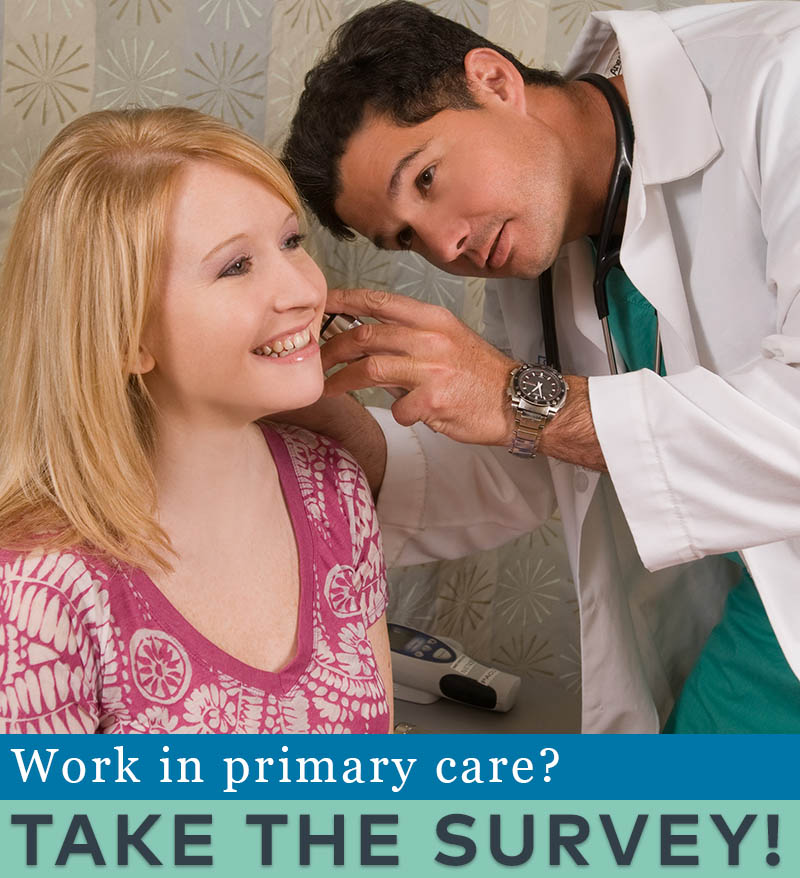Check back weekly for the latest survey results and updates.
For data from the previous survey, see Week 18 Results.
Who replied to the survey in Week 19?
The Primary Care Collaborative is partnering with the Larry A. Green Center to regularly survey primary care clinicians and patients to better understand the impact of COVID-19 in real time.
636 primary care clinicians from 47 states and Washington, D.C., responded to the survey fielded between August 21 and 24, 2020. Respondents’ specialties include: family medicine, 74%; internal medicine, 11%; pediatrics, 6%; geriatrics, 4%; other, %. 30% own their practice, 43% of practices are owned by a hospital or health system, 12% are independent and part of a larger group, and 3% are government-owned. 41% report a practice size of 10 or more clinicians, 30% report a practice size of 4-9 clinicians, and 29% report a practice size of 1-3 clinicians. 10% report practicing in a primary care and convenience care setting, 24% in a rural setting, 31% in a patient-centered primary care home, 11% in a community health center, and 10% in an office, school or college.
Results at a glance
Clinicians have noticed increased stress in patients’ lives.
Clinicians report seeing higher stress and pressures on their patients. The most common symptoms or causes are: higher levels of mental health concerns (86%); more sleep issues (77%); weight gain (73%); becoming more involved in providing mental health support to others (70%); and struggling to pay bills (58%). Three in four clinicians say they are able to assist their patients with their mental health concerns.
In addition, 34% of clinicians have seen higher levels of food insecurity among patients, and 38% have seen higher levels of housing insecurity.
Clinicians are also experiencing stress in their jobs, but they are able to keep working.
More than half (56%) say their levels of strain from COVID-19-related changes and pressures in their practice were at either a 4 or 5 (out of 5) in the previous four weeks. The most-cited pressures are, by far: clinicians/staff out due to illness or self-quarantine (47%); lack of staffing, making it harder to meet patient needs (46%); and in-person patient visits are 30-50% lower than pre-pandemic levels (46%).
Despite worries of practice closures earlier in the pandemic, an overwhelming number (89%) of clinicians are confident in the ability of their practice to stay open for the next 4 weeks. More than 4 in 10 (44%) are currently receiving financial support through federal programs (CARES, SBA, PPP, PRF). And despite the many frustrations that clinicians have experienced throughout the public health emergency, almost 2 in 3 (66%) say they are not considering leaving primary care.
Some of these pressures are also affecting the quality of care in the practice. A quarter (24%) of clinicians said their practice has shut down quality initiatives, a third (34%) have cut back the number of services offered to patients, and a third (34%) have reduced/cut educational training.
Some practices are engaging in public health efforts outside their practice.
41% are in regular contact with their public health department, and 15% are assisting with contact tracing.
Learn more: Download the Series 19 Clinician Survey Executive Summary (includes select open-ended answers to survey questions)
Voices from the Primary Care Front Lines
The ongoing stresses show little sign of lifting.
The worries and stresses are intense for families and those who care for them. There has been little attention paid to how we go forward for an extended, and unknown, period of time and what those effects will be and how it magnifies even more the disparities between the haves and the have nots. (Michigan)
I'm working 120+ hrs/wk and haven't taken any salary since March. I don't know how much longer I can hold on. I don't want the stress of this all to kill my family OR my community. This is the first week I've been so exhausted and depleted that I almost didn't have it in me to fill out this survey. (Colorado)
Burnout is at an all-time high with low reimbursements, huge stress managing staff, staff illness and coverage, and a huge likely unrecoverable financial burden as a small practice. (Oregon)
Patients’ needs are expanding, telehealth shows continued benefits, yet future support of this tool is unclear.
Addressing isolation concerns of patients. It's a human thing. We need to do better to help. (Massachusetts)
Patients have gained weight. They are experiencing more anxiety and depression. Insomnia is high. (Kansas)
LOTS more time counseling patients re emotional health and appropriate management strategies. (Virginia)
Commercial payers need to cover virtual annual wellness visits on parity with face to face as does CMS. Patients are falling behind on preventative medical care. (Texas)
New concerns are arising.
Just got information on pricing for flu vaccine this year. It will cost me over $5000 for 100 doses & I'm not sure how to pay for it or if I will get reimbursed. How am I supposed to provide preventative care when I can barely pay my staff & rent? (Washington)
Having to take care of University faculty, staff and students with testing has put extreme demands on our resources and is rapidly increasing stress among our employees as students return to campus and schools reopen. This reduces our staff because of childcare issues, while patient demand and testing increases. (Alabama)
| Attachment | Size |
|---|---|
| 709.25 KB |

Are you a physician, nurse practitioner, or PA working in primary care?
Help PCC and the Larry A. Green Center track how your practice is responding to the COVID-19 outbreak by completing the Green Center's occasional survey.
The regular surveys are no longer being conducted.
COVID-19 Updates
December 4, 2021 | Washington Post
December 3, 2021 | CMS
November 22, 2021 | The Commonwealth Fund
November 17, 2021 | Primary Care Collaborative
October 18, 2021 | Primary Care Collaborative
- ‹ previous
- 3 of 39
- next ›
Recent News
March 19, 2024
February 28, 2024
February 22, 2024 | Conversations on Health Care
Statement from @AnnGreiner1: "Today’s new @CMSinnovates announcement is a promising step forward for #primarycare p… https://t.co/A6l5Rt9Fzb —
10 months 2 weeks ago
RT @LarryMcNeely1: @brookslasure says #primarycare relationship is foundation of care...announcing the "Making Care Primary" model from @C… —
10 months 2 weeks ago
RT @LarryMcNeely1: stressing alignment w Medicaid. 8 States participating including CO, NM, MA. —
10 months 2 weeks ago
Secondary menu
Copyright © 2024 Primary Care Collaborative




